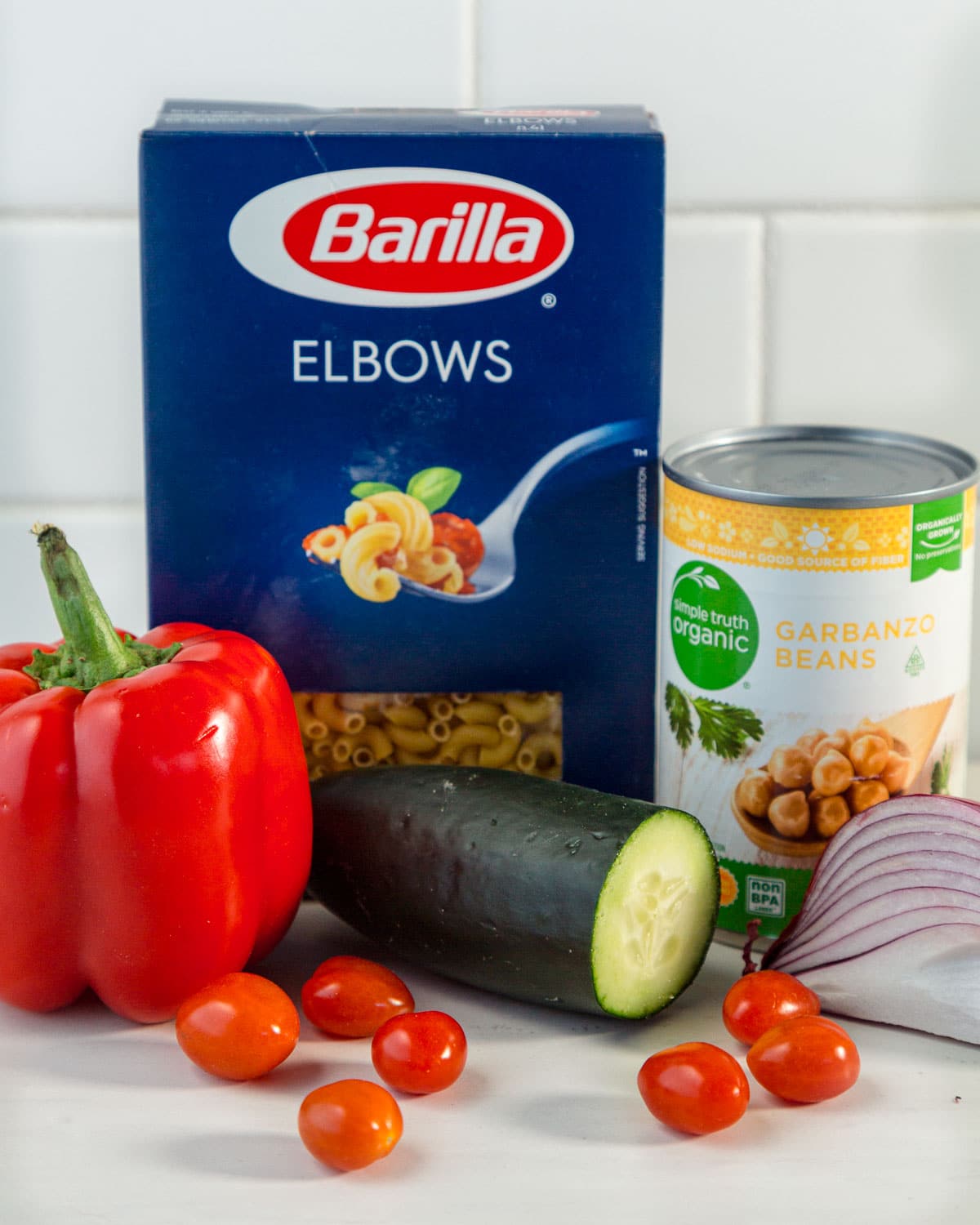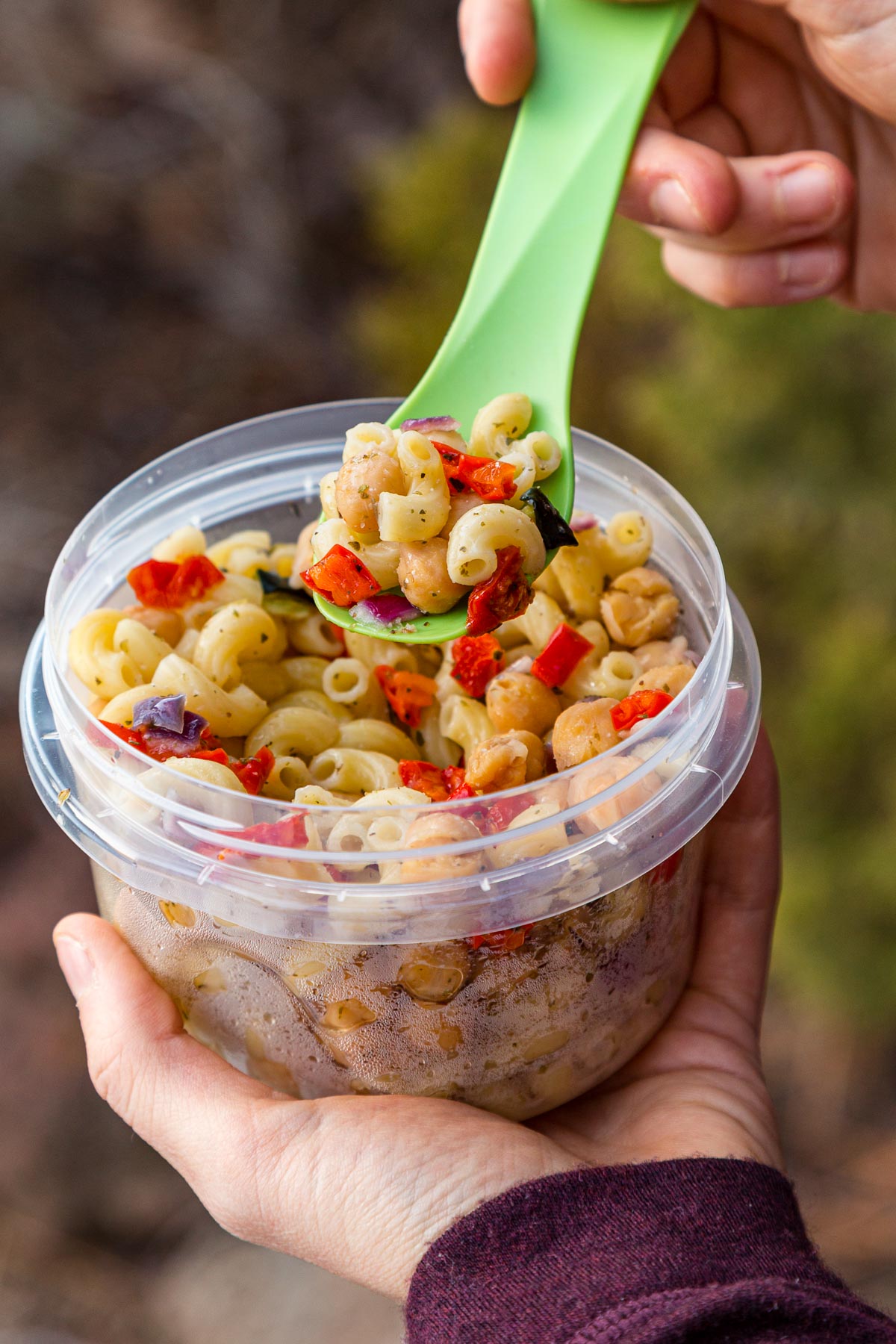Cold Soaked Pasta Salad
This post may contain affiliate links.
This dehydrated pasta salad is chock full of veggies, protein, and FLAVOR, and can be rehydrated on the trail without the need for a stove!

Backpacking lunches have always presented us with somewhat of a conundrum. On one hand, we want something satisfying and delicious, but on the other, we absolutely refuse to break out our stove and cook. So what’s to be done? One answer we’ve found is cold soaking.
“Cold soaking” is a term generally used to describe a no-cook method of backpacking food preparation, where dehydrated food is placed in a leak-proof container and covered with water, then allowed to rehydrate slowly without any heat. It’s super simple and great for lunches or for those who want to backpack without a stove.
We’ve seen a number of good vessels for cold-soaking. Really the only qualifier is that it needs to be completely leakproof if you’re going to carry it in your pack while your food is soaking, and it’s helpful for the container to have a wide mouth to make eating from it easier.
Talenti jars, the Vargo BOT, and these lightweight screw-top containers (pictured in the photos of this post) are all good choices. Recently, we have just been using our backpacking mugs, which have a water-tight lid… Though we do choose to carry these in our water bottle pockets instead of inside our packs, just in case.

Why We Love This Cold-Soak Pasta Salad
- Ingredients are dehydrated at home, so it’s just as light as any other dehydrated meal
- No-stove cold-soaked method means we don’t have to break out the stove in the middle of the day
- Full of healthy ingredients like veggies and chickpeas
- Tastes just like you picked it up at the local Italian deli!
So if you’re ready to trade in your tuna packets and tortillas for something else, we would definitely recommend giving this cold soak pasta salad a try!

Equipment Needed
Dehydrator: Any dehydrator that has an adjustable temperature setting will work. We own the Nesco Snackmaster (budget-friendly) and a Cosori (more features, quieter, and dries faster) and recommend both.
Reusable bags: In our bid to reduce our disposable ziplock bag consumption, we’ve started packing our dehydrated meals in reusable baggies. ReZip is a great option, balancing durability with weight. Most of their bags weigh between ½ – 1 oz.
Leak-proof container: Talenti jars, the Vargo BOT, and these lightweight screw-top containers (pictured in the photos of this post) are all good choices.

Ingredient Notes
Pasta: We used a classic macaroni elbow-style shape here. We also tested this recipe with ditalini and mini rigatoni, which would both work fine. We found in our testing that it is, in fact, important to pre-cook the pasta and dehydrate it. It doesn’t change the weight or the soaking time really, BUT the texture of the pre-cooked/dehydrated pasta is superior. We found that cold soaking “raw” pasta resulted in a gummy texture.
Chickpeas/Garbanzo beans: This recipe calls for one can of chickpeas—though you can substitute with 1 ½ cup of home-cooked beans if you prefer. Drain and rinse canned chickpeas.
Vegetables: Feel free to substitute with whichever veggies you prefer, but we stuck to classic deli-style vegetables here: cucumbers, red onions, bell peppers, and tomatoes. The cucumbers and bell peppers give a welcome crunch to the salad. One word of caution, though: onions can get pungent when dehydrating, so place your dehydrator in a well-ventilated area, or you can use freeze-dried red onion instead.
True Lemon: These handy packets give the dressing a lemony zing.
Olive oil: To up the calories and create the dressing, pack along some olive oil. You can either bring a small container of oil (we like this one), or pack single-serve packets.

How to Dehydrate Pasta Salad
At home: Start with clean, sanitized equipment, hands, and work area. This is super important for food safety when dehydrating, so wash up with soap and hot water!

Dice all the vegetables into small, uniform pieces, ideally about ¼” large. Drain and rinse the chickpeas.
Bring a quart of salted water to a boil. Add the pasta and cook one minute less than the package directions state. Remove from the heat, strain, and run cold water over the pasta to stop the cooking.

Line dehydrator trays with parchment paper or use the liners that came with your dehydrator. Spread the pasta onto one or two trays in an even layer. Arrange chickpeas, diced red onion, diced cucumber, and diced tomatoes onto additional trays, making sure that there is room around individual pieces to allow for air circulation.
Dehydrate at 125F for 6-10 hours, or until completely dry. Some ingredients may take longer than others.
If you’re new to dehydrating, read our complete guide to dehydrating food for backpacking to learn all the ins and outs!

To pack for the trail: Place the dehydrated ingredients into a sealable bag (or divide between two bags for individual portions) or container and add the remaining seasonings and the True Lemon packet. Pack olive oil in a small sealable bottle.
On trail: At least an hour and a half before lunch, set aside the True Lemon packet and add 200mL (between ¾ cup – 1 cup) water per serving to the dehydrated ingredients.
Once the salad has rehydrated and the pasta is tender, add the olive oil and True Lemon to taste.
Read this next: Here are dozens of lightweight backpacking recipes to try on your next backpacking trip!
Storage Tips
The length of time that dehydrated meals can be stored for can vary depending on the storage method and conditions. Here are some tips for best results:
- Store your dehydrated food in a cool, dry, and dark place. Moisture can ruin your food and make it unsafe to eat, while heat and light will cause the nutrients and flavors to degrade over time.
- Dehydrated food should be stored in airtight containers, especially if you’re going to store them for more than a week or two. If we’re packing a meal for this weekend’s trip, we might just put it in a reZip and then straight into our food bag. But if you’re prepping for a trip that is further out, package your food in a sealed mason jar, a Mylar bag with an oxygen absorber, or vacuum seal it into individual servings.
- Since this meal is dairy and meat-free as written, you don’t need to store this in the fridge if everything is dehydrated and packaged properly.
- For best results, we recommend consuming this meal within six months, but it can last for longer if vacuum sealed.
- Of course, some report that their dehydrated food lasts much longer, and some foods may not last as long due to dehydrating and storage conditions. When in doubt, discard any questionable food!

Trail Weight & Nutrition
This recipe makes two 117g servings (dry weight), clocking in at 133 cal/oz once you add the olive oil (assuming 1 olive oil packet per serving). Each serving provides:
- 558 calories
- 18g fat
- 84g carbohydrates
- 20g protein
Feel free to package the dehydrated pasta salad in larger or smaller portions depending on your appetite! For more information about how much food to eat while backpacking, check out our backpacking meals post.
(Disclaimer: Nutrition was calculated based on the ingredients we used, so yours may vary slightly.)

Cold Soaked Pasta Salad
Ingredients
- 1 cup 4 oz. elbow pasta
- 15 oz. can chickpeas drained and rinsed
- ½ large red bell pepper diced
- ¼ cup diced red onion
- ¼ cup diced cucumber
- 10 cherry tomatoes diced
- ¾ teaspoon garlic powder
- ¾ teaspoon dried oregano
- ½ teaspoon sea salt
- 2 tablespoons olive oil
- 1 packet True Lemon
Instructions
At Home
- Bring a quart of salted water to a boil. Add the pasta and cook one minute less than the package directions state. Remove from the heat, strain, and run cold water over the pasta to stop the cooking.
- Line dehydrator trays with parchment paper. Spread the pasta onto one or two trays in an even layer. Arrange chickpeas, diced red onion, diced cucumber, and diced tomatoes onto additional trays, making sure that there is room around individual pieces to allow for air circulation.
- Dehydrate at 125F for 6-10 hours, or until completely dry. Some ingredients may take longer than others.
To Pack for the Trail
- Place the dehydrated ingredients into a sealable bag (or divide between two bags for individual portions) or container and add the remaining seasonings and the True Lemon packet. Pack olive oil in a small squeeze bottle.
On the Trail
- At least an hour and a half before lunch, set aside the True Lemon packet and add 200mL (between ¾-1 cup) water per serving to the dehydrated ingredients. If you will be hiking during the soaking time, make sure this is done in a watertight container: Twist & Lock tupperware, Talenti or peanut butter jars are popular options and will hold about one serving each.
- Once the salad has rehydrated and the pasta is tender, add the olive oil and True Lemon to taste.


Such a well written recipe! Comprehensive and enjoyable, thank you! I’ll definitely be trying this for a break from lunch wrap fatigue.
The lunch wrap fatigue is real. Hope you enjoy this!
I really liked this recipe, but I’m glad I didn’t use the entire bag of True Lemon… I only used a pinch, and I think it ruins everything. I love lemon, though; I make lemon water with pure lemon juice every day.
Personally, I would never add this powder to any recipe, no matter what it is.
Hi Mélanie, sorry to hear that adding the True Lemon made this recipe a miss. It can definitely be omitted next time. Thanks for the feedback!
if you are in 90F plus temps, how long is it safe to let the food soak? I’ve read that for oats, 60 min is the max for 90+ and 120 min for 40+. Unsure if that guideline is specific to oats or to all rehydrated/cold soak recipes
Great question! That guideline would apply to any cold soak recipe, not just oats. According to the USDA, food shouldn’t be left out for more than an hour if it’s above 90°F.